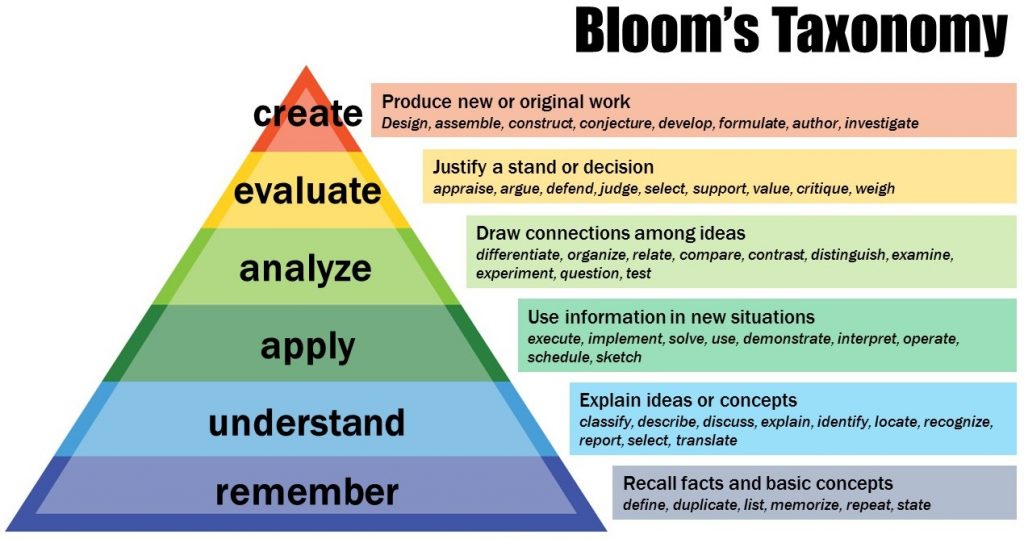A Blog post
Level up studying with Bloom’s Taxonomy
-
 Aug 14, 2018
Aug 14, 2018 -
 Jared Wells
Jared Wells -
 In Uncategorized
In Uncategorized -
 0 Comments
0 Comments

It isn’t how long or hard you study, it’s HOW you study.
One of most common complaints parents have when the come in to speak with me is “My son/daughter spends so much time and effort studying, but isn’t performing well on tests.”
But how long you study, or how "hard" you study, doesn't have as much impact on results as you think. What matters is how effectively you study. And most students do not study effectively.
One of the key themes we keep returning to in our Study Skills workshop is “leveling up” your studying. That is, recognizing that “studying” is not the same as “studying effectively”. That if you need to be able to perform at a certain level of thinking on a test, you need to have practiced that level (and higher) levels of thinking previously. And “just” reading the chapter and mindlessly working through homework problems isn’t practicing higher levels of thinking.
One way to understand levels of thinking is to look at “Bloom’s Taxonomy”, which is a hierarchy of thinking skills posited by Benjamin Bloom in 1956. The updated version of this taxonomy looks like this:
Level 1: Remembering
Ability to repeat a piece of information after a period of time.
Example: Remembering the fact that Pearl Harbor was attacked on December 2nd 1941.
Level 2: Understanding
Ability to explain a concept in your own words, give examples, or summarize.
Example: Being able to explain that Pearl Harbor was attacked because Japan was trying to knock the USA out of the war with a decisive victory.
Level 3: Applying
Ability to use the information in ways that haven’t been explicitly taught.
Example: In an essay about American isolationism in the 1920’s and 30’s, using the attack on Pearl Harbor as a bookend to that period.
Level 4: Analyzing
Ability to organize information in new, useful structures, and understand relationship between ideas.
Example: Explaining why and how the attack on Pearl Harbor ultimately led to Japan’s defeat.
Level 5: Evaluating
Ability to determine the relative value of an idea in a context.
Example: Participating in a debate on whether the attack on Pearl Harbor was militarily, economically, or morally justified from Japan’s perspective.
Level 6: Creating
Ability to use ideas to create something new.
Example: Writing a fictional (but historically reasonable) account of an alternate history in which the attack on Pearl Harbor led to a Japanese victory over the USA.
I’ll also suggest that there exists a level 0 that many students who believe they have studied are at: decoding. That is, they’ve read the material passively, and don’t remember much of what they’ve read (but believe that, because they read the material, they have studied).
How can Bloom’s taxonomy improve the quality of our students’ studies?
The key idea is that, the farther your studying goes down the list, the more certain you are to have mastered the concept at the previous levels.
So, for example, if you have a vocabulary test in Spanish (level 1) using the words you are studying in conversation (level 3) is good preparation, and a good indication of preparedness.
If you have a chemistry exam on balancing reactions (level 2 or 3) being able to teach your friends how to do it (levels 4-6) is good preparation, and a good indication of preparedness.
If you have a math test on solving systems of equations (level 1 or 2), being able to solve the “challenge” word problems at the end of the chapter (level 3 or 4) is good preparation, and a good indication of preparedness.
The thread that runs through Bloom’s Taxonomy is increasing levels of engagement with the material. Success on a test requires high levels of engagement in preparation.
How do your children “level up” their studying?
-Vince
Archives
Contact Us
Got a question? We'd love to hear from you.
Send us a message and we'll respond as soon as possible.

 Aug 14, 2018
Aug 14, 2018  Jared Wells
Jared Wells  In Uncategorized
In Uncategorized  0 Comments
0 Comments

Comments